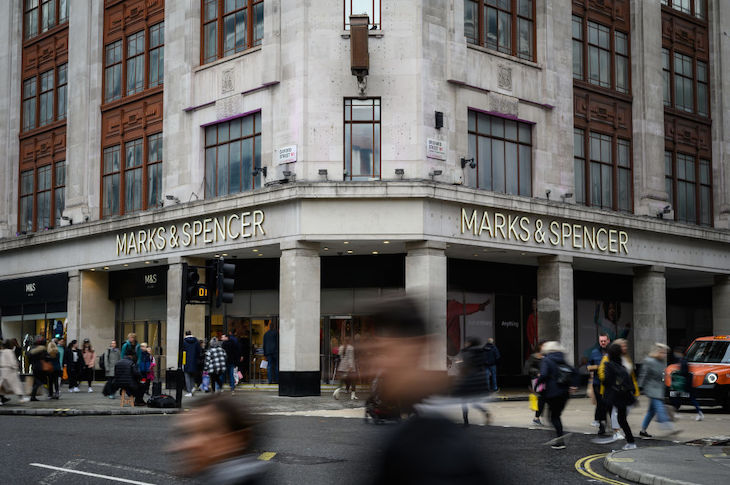Oxford Street – the busiest shopping street in Europe, in a nation once known as an island of shopkeepers – has had at its heart two fine Art Deco monuments to British mercantilism: Selfridges and Marks & Spencer. But in December, the deputy prime minister Angela Rayner granted permission for M&S to demolish and redevelop its flagship London store and replace it with a drab slab of modernism.
For devotees of Art Deco architecture and anyone who cares about beautiful buildings, this is an act of philistinism. But there may still be a glimmer of hope for Oxford Street. London’s mayor, Sadiq Khan, has opened a consultation (ending on 2 May) on the future of Oxford Street. Could this mark a turning point, a chance to reimagine this great thoroughfare for the 21st century?
Khan says that he wants to turbo-charge the regeneration of Oxford Street and create a ‘beautiful space where people can shop, eat and connect.’ Perhaps he might have a word with his Labour colleagues and put a stop to the erection of a hideous building to replace the dignified M&S store.
M&S’s argument for its new building has been consistently inconsistent. Initially, it was couched by supporters in respect of energy and carbon savings. This was a surprise to environmental campaigners, given that the building work is likely to generate up to 39,500 tonnes of C02 emissions.
The other argument was weaker still: that a new build would revitalise the High Street. This was a curious position to take, given that the existing building’s facades are among the most character defining features of Oxford Street.
The tragedy of M&S’s determination to pull down its Oxford Street building is that it doesn’t have to be this way. English architect Francis Terry, in conjunction with Create Streets, has published an alternative culturally sympathetic option. His version embraced the pre-war Trehearne and Norman architecture by retrofitting it to suit modern day retail and commercial development. Crucially, the proposal provided a comparable development square footage and at a similar cost. Yet M&S wasn’t persuaded.
This refusal to see sense is a pity. Terry’s version sought to retain the proud, handsome building which has housed generations of shoppers since the 1920s whilst creating grand and uplifting arcades. As Nicholas Boys Smith observed, it embraced the ‘splendid’ architectural framework that M&S, and its neighbour Selfridges, provide.
It was not a totally purist approach; it supported the demolition of the post war bolt-on at the rear of the original. A Deltapoll survey in February 2024 found the British public overwhelmingly preferred the Terry design by 79 per cent to 17 per cent. Terry’s blueprint was seen as a chance to embrace the best, and improve the worst of the building – but it’s an opportunity which has, seemingly, been spurned.
The problem is not with the concept of the demolition per se, but also the tedious mediocrity of the proposed replacement – what Boys Smith described, accurately, as a ‘generic 1970s pastiche… complete with a graph-paper façade and a deadening grid of identical windows.’ Any replacement should surely have to be an improvement on the past. But it must also be thoughtful, respectful, interesting – and definitely not dreary.
So where do Labour sit with this? It is an ironic tragedy that they have had to use their endorsement of M&S’s proposal to signpost that they understand growth, enterprise and ‘building for the future.’ Perhaps their October Budget backed them into a corner, forcing them to desperately signal that they understand that the state can indeed be an agent for nurturing enterprise.
Whatever the reason, we must keep our fingers crossed for the Mayor’s consultation. Few will disagree with the exile of candy stores and many will applaud the renewed attempt to pedestrianise London’s former tourist shopping jewel. But sitting as it does in the shadow of the decision to demolish, do we really have confidence that public bodies possess the ability or eye for design to achieve Khan’s goals?
Approving the demolition of the M&S building was a mistake. As Terry has shown, heritage can indeed be combined with growth. His proposal enhanced the character of Oxford Street, injecting life into a High Street in need. But the necessity for knee-jerk pro-business optics was simply too great. A landmark building – and Khan’s dream of revitalising Oxford Street – risks being lost.







Comments